These tests below only note my personal opinion for the ESTIMATED ratings for the batteries I tested at the time I tested them. Any battery that is not a genuine Samsung, Sony, Murata, LG, Panasonic, Molicel, EVE, Lishen, BAK, or Sanyo can change at any time! This can be one of the hazards of using “rewrapped” or batteries from other manufacturers so carefully research any battery you are considering using before purchasing.
Misusing or mishandling lithium-ion batteries can pose a SERIOUS RISK of property damage, personal injury, or even death. Never use them outside of a fully protected battery pack and you use them at your own risk. Never exceed the battery’s true continuous discharge rating (CDR), never let it get colder than 0°C or hotter than 60°C to help lower the risks and extend cell life, and keep the plastic wrap and top insulating ring in perfect condition. Never use a battery that is physically damaged in any way.
Testing batteries at their limits is dangerous and should never be attempted by anyone who has not thoroughly studied the dangers involved, understands the risks, has the proper equipment, and takes all appropriate safety precautions.
If the battery has only one current rating number, or if it only says "max", then I have to assume the battery is rated at that current level for any type of discharge, including continuous.


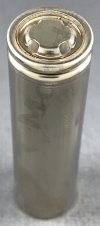
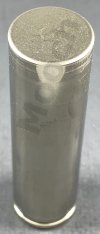
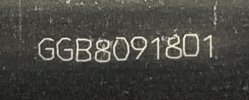
Test Results
It’s been a while since I last tested the Molicel P30B and it now has the China Compulsory Certification (CCC) required wrap printing showing the model number, polarity marks, minimum capacity, nominal voltage and “CCC”. This certification requires the cell to undergo additional testing if manufactured or sold in China and is a good thing to see.
These 2024-dated cells are incredible performers, doing even better than the last time I tested the P30B. The P30B is replacing the P28A (P28B was never a production cell) and is now my top choice for any use at above about 7A or so. For about 5A or lower the EVE 35V runs for a bit longer.
In the Moli spec sheet the P30B’s 30A rating is temperature-limited to an 80°C max cell temp but the cells I tested only reached about 78°C at 30A down to 2.5V. This seems to be a true continuous 30A rating.
Some other results and info…
Continuous Current Discharge Graphs
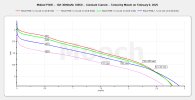
Ratings and Performance Specs Graphic
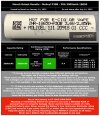
18650 Ratings & Performance Table:
 www.e-cigarette-forum.com
www.e-cigarette-forum.com
20700/21700 Ratings & Performance Table:
 www.e-cigarette-forum.com
www.e-cigarette-forum.com
I want to work for the community full time! If you feel what I do is worth a couple dollars a month and you would like early access to battery availability, battery testing and news, and a say in what I test, then please consider becoming a patron and supporting my testing efforts: Get more from Battery Mooch on Patreon.
Misusing or mishandling lithium-ion batteries can pose a SERIOUS RISK of property damage, personal injury, or even death. Never use them outside of a fully protected battery pack and you use them at your own risk. Never exceed the battery’s true continuous discharge rating (CDR), never let it get colder than 0°C or hotter than 60°C to help lower the risks and extend cell life, and keep the plastic wrap and top insulating ring in perfect condition. Never use a battery that is physically damaged in any way.
Testing batteries at their limits is dangerous and should never be attempted by anyone who has not thoroughly studied the dangers involved, understands the risks, has the proper equipment, and takes all appropriate safety precautions.
If the battery has only one current rating number, or if it only says "max", then I have to assume the battery is rated at that current level for any type of discharge, including continuous.





Test Results
It’s been a while since I last tested the Molicel P30B and it now has the China Compulsory Certification (CCC) required wrap printing showing the model number, polarity marks, minimum capacity, nominal voltage and “CCC”. This certification requires the cell to undergo additional testing if manufactured or sold in China and is a good thing to see.
These 2024-dated cells are incredible performers, doing even better than the last time I tested the P30B. The P30B is replacing the P28A (P28B was never a production cell) and is now my top choice for any use at above about 7A or so. For about 5A or lower the EVE 35V runs for a bit longer.
In the Moli spec sheet the P30B’s 30A rating is temperature-limited to an 80°C max cell temp but the cells I tested only reached about 78°C at 30A down to 2.5V. This seems to be a true continuous 30A rating.
Some other results and info…
- At 5A the P30B equals or runs for a bit longer than the VTC6, MJ1, and 30Q6.
- At 10A-30A the P30B outperforms every 18650 I have tested, sometimes by a little, sometimes by a lot.
- The Moli web site mentions a 36A max current rating and 100W max power rating. Stay under 80°C cell surface temperature!
- P30B’s do not have the laser-etched QR-style code box on the bottom like the P45B and P50B. But they do have a tiny laser-etched code on the side of the can with the last six characters seeming to match the date code on the wrap. This appears to be a great way to authenticate a cell…until counterfeiters buy laser etching printers.
- DC IR for the two cells I tested measured 9.4mOhms and 9.4mOhms. This is extraordinary consistency and is what makes Molicels so great, especially for pack building.
- Capacities for the two cells was 3007mAh and 3008mAh, also also extraordinary consistency.
- The standard charge rate is 3A and the maximum rate is 9A (temp-limited to 60°C). Like all cells I’m sure that the cycle life will be shorter if charging at the max rate a lot.
Continuous Current Discharge Graphs

Ratings and Performance Specs Graphic

18650 Ratings & Performance Table:
18650 Battery Ratings and Performance Table
You are responsible for your own safety! These batteries are designed, manufactured, and sold only for use in a battery pack with the proper protection circuitry and battery management system. They were not designed for vaping (electronic...
 www.e-cigarette-forum.com
www.e-cigarette-forum.com
20700/21700 Ratings & Performance Table:
21700 Battery Ratings and Performance Table
You are responsible for your own safety! These batteries are designed, manufactured, and sold only for use in a battery pack with the proper protection circuitry and battery management system. They were not designed for vaping (electronic...
 www.e-cigarette-forum.com
www.e-cigarette-forum.com
I want to work for the community full time! If you feel what I do is worth a couple dollars a month and you would like early access to battery availability, battery testing and news, and a say in what I test, then please consider becoming a patron and supporting my testing efforts: Get more from Battery Mooch on Patreon.
